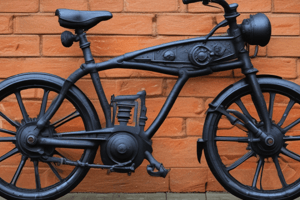Podcast
Questions and Answers
What is one of the properties of cast iron in terms of brittleness?
What is one of the properties of cast iron in terms of brittleness?
- It can withstand high temperatures.
- It shows high tensile strength.
- It is brittle and heavy. (correct)
- It is flexible and ductile.
What process is primarily used to purify pig iron to create steel?
What process is primarily used to purify pig iron to create steel?
- Hydrogenation process
- Carbonization process
- Oxidation process (correct)
- Reduction process
Which element is NOT typically part of ordinary cast iron's composition?
Which element is NOT typically part of ordinary cast iron's composition?
- Phosphorus
- Carbon
- Silicon
- Copper (correct)
What is the primary benefit of wrought iron's fibrous nature?
What is the primary benefit of wrought iron's fibrous nature?
Which method of steel-making involves using a gas and air mixture to provide heat?
Which method of steel-making involves using a gas and air mixture to provide heat?
How does the addition of lime contribute in the Open Hearth Process?
How does the addition of lime contribute in the Open Hearth Process?
What percentage of scrap steel can be involved in the Basic Oxygen Steelmaking process?
What percentage of scrap steel can be involved in the Basic Oxygen Steelmaking process?
What is one key benefit of tungsten in steel production?
What is one key benefit of tungsten in steel production?
Which of the following statements accurately describes ferrous metals?
Which of the following statements accurately describes ferrous metals?
What is the main characteristic of wrought iron that distinguishes it from other forms of iron?
What is the main characteristic of wrought iron that distinguishes it from other forms of iron?
How is the classification of steels indicated by numbering, as per the content?
How is the classification of steels indicated by numbering, as per the content?
What is the role of tungsten in addition to improving tensile strength?
What is the role of tungsten in addition to improving tensile strength?
Which of the following best describes non-ferrous metals?
Which of the following best describes non-ferrous metals?
What is the primary purpose of annealing steel?
What is the primary purpose of annealing steel?
Which process involves heating steel to its upper critical point and then allowing it to cool freely in air?
Which process involves heating steel to its upper critical point and then allowing it to cool freely in air?
What happens to high carbon steel when it is rapidly cooled after being heated above its critical point?
What happens to high carbon steel when it is rapidly cooled after being heated above its critical point?
What is the effect of tempering steel after it has been hardened?
What is the effect of tempering steel after it has been hardened?
Which of the following options correctly describes the cooling process in annealing?
Which of the following options correctly describes the cooling process in annealing?
For steel containing more than 0.87% carbon, what is the heating process before annealing?
For steel containing more than 0.87% carbon, what is the heating process before annealing?
What causes increased grain size in steel during the forging process?
What causes increased grain size in steel during the forging process?
What is the main characteristic of steel that affects its hardness during the hardening process?
What is the main characteristic of steel that affects its hardness during the hardening process?
What happens as a metal cools and crystallizes from a molten state?
What happens as a metal cools and crystallizes from a molten state?
What is meant by the term 'grain' in the context of metals?
What is meant by the term 'grain' in the context of metals?
Which statement best characterizes elastic deformation in metals?
Which statement best characterizes elastic deformation in metals?
How do the atoms in a crystalline metal arrange themselves?
How do the atoms in a crystalline metal arrange themselves?
What occurs during plastic deformation of metals?
What occurs during plastic deformation of metals?
What does the term 'dendrite' refer to in metal crystallization?
What does the term 'dendrite' refer to in metal crystallization?
How can the grains in metal be made visible?
How can the grains in metal be made visible?
What impacts the arrangement of atoms in a crystal structure of metal?
What impacts the arrangement of atoms in a crystal structure of metal?
What is the primary purpose of the Rockwell hardness tester?
What is the primary purpose of the Rockwell hardness tester?
Which impact test is primarily required by most British material specifications?
Which impact test is primarily required by most British material specifications?
What does cyclic stressing refer to in the context of materials?
What does cyclic stressing refer to in the context of materials?
What is measured during the impact tests using a pendulum weight?
What is measured during the impact tests using a pendulum weight?
During which scenarios do cyclic stressing actions occur in aircraft structures?
During which scenarios do cyclic stressing actions occur in aircraft structures?
Which test is preferred when testing a material at high or low temperatures?
Which test is preferred when testing a material at high or low temperatures?
What is the consequence of temper brittleness in materials?
What is the consequence of temper brittleness in materials?
What signifies fatigue failure in materials?
What signifies fatigue failure in materials?
Flashcards are hidden until you start studying
Study Notes
Cast Iron
- Cast iron is a cheap metal with good rigidity and strength under compression.
- It is also easy to machine and cast.
- It can be made stronger and tougher by altering its composition.
- Cast iron contains 3.0 to 4% carbon, 1.0 to 3.0% silicon, 0.5 to 1.0% manganese.
- It also contains up to 0.1% sulfur (which causes brittleness) and up to 1.9% phosphorus.
- Chromium (0.5 to 1.0%) is added for stainless steel.
- Cast Iron is also brittle and heavy.
Wrought Iron
- Wrought iron is almost pure iron (99.9%).
- It is made by oxidizing almost all of the carbon and other elements from pig iron.
- It can withstand large shock loads without permanent damage.
- It was used for making chains and lifting hooks.
- Its fibrous nature warns of potential breakage.
Steel
- Steel is made by oxidizing pig iron.
- Scrap steel can also be used in the process.
- Three methods for making steel are: Open Hearth Process, Basic Oxygen Process, and Electric Furnace Process.
Open Hearth Process
- The Open Hearth Process uses a mixture of gas and air to generate heat for melting pig iron and scrap.
- Gas and air are preheated in "regenerators."
- Lime is added to create a basic slag that removes phosphorus.
- Anthracite is added to increase carbon content in the molten steel.
- Molten steel is poured into molds to create ingots.
Basic Oxygen Steelmaking
- A basic oxygen furnace is lined with dolomite, capable of holding up to 400 tons of metal.
- The charge consists of scrap steel, lime, and molten pig iron, with oxygen blown at the surface.
Crystal Structure
- Metals are crystalline, meaning their atoms are arranged in a regular pattern.
- This arrangement allows us to consider atoms as lying in planes with different densities.
- Crystal structure is not always visible, but can be revealed by etching.
- The term "grain" describes crystals without their geometric shapes, often due to interference from other crystals.
Formation of Metal Grains
- As a metal solidifies, crystallization occurs around impurities.
- Crystals grow into a "tree-like" structure called a dendrite.
- When dendrites collide, they fill in the spaces to create solid metal.
Deformation of Metals
- Elastic Deformation occurs when a metal returns to its original shape after stress is removed.
- Plastic Deformation occurs when a metal does not return to its original shape after stress is removed.
- Plastic deformation involves planes of atoms sliding past each other.
Annealing
- Annealing softens metals by heating them and then allowing them to cool slowly.
- Stress relieving, recrystallization, and grain growth are all benefits of annealing.
- Steel containing up to 0.87% carbon is heated to its upper critical point.
- This brings it to austenitic form and allows for slow cooling which brings it back to pearlite and ferrite or pearlite condition.
Normalizing
- Normalizing relieves internal stresses and strains by heating the steel to its upper critical point and then allowing it to cool in air.
- It restores the crystalline structure and reduces stresses and strains.
- Normalizing leads to a finer grain structure compared to annealing, which causes a more rapid cooling rate.
Hardening
- Hardening involves heating high-carbon steel to a temperature above its upper critical point and then rapidly cooling it.
- This process prevents the normal structural change and transforms austenite into martensite, which is hard and brittle.
- The degree of hardness depends on the carbon content.
- Quenching is performed in water or oil, with oil providing a slower quench and resulting in a less hard but tougher steel.
Tempering
- Tempering reduces the brittleness caused by hardening.
- It increases tensile strength and ductility.
- It prevents brittleness in nickel/chrome steels when they are heated.
Tungsten
- Tungsten improves heat and wear resistance.
- It is used in cutting tools and many aircraft applications requiring high strength.
Ferrous Metals
- Ferrous metals are those containing iron as a primary component, including cast iron and steel.
- Aircraft steels are broadly classified as wrought carbon and alloy, or heat and corrosion resistant.
Standard Steel Designations
- The first digit indicates the general classification (e.g., 1 for carbon steel).
- The second digit indicates the approximate percentage of the main alloying element (e.g., 2330 steel contains more than 3% nickel).
- The last two digits show the approximate carbon content in hundredths of 1%.
Rockwell Hardness Tester
- It's a widely used test for measuring the hardness of materials.
- The hardness number is directly displayed on the dial, eliminating the need to measure the impression diameter.
Shore Scleroscope Test
- This test uses a small hammer to determine the hardness of materials.
- The scale reads the rebound height of the hammer to determine the hardness.
Impact Test
- Impact tests evaluate the toughness of a material and its resistance to mechanical shock.
- They ensure that temper brittleness has not been introduced during heat treatments.
- Two types of tests exist: Izod and Charpy.
- The Izod test is used for most British material specifications, while the Charpy test is used for testing materials at high or low temperatures.
- Both tests use a pendulum weight to fracture the specimen, and the energy absorbed is measured.
Fatigue Testing
- Fatigue testing involves subjecting a material to repeated cycles of stress to determine its resistance to failure.
- It is crucial for understanding how materials respond to cyclic loading.
- Factors that cause fatigue are discussed below.
Cyclic Stressing: Causes of Fatigue Failure
- Cyclic stressing refers to the repeated application of stress to a material, often causing it to fatigue and fail eventually.
- Aircraft structural and component examples of cyclic stress:
- Pressurization of the cabin
- Turbulence and vibration during various flight conditions.
- Temperature changes, especially in the engine due to thermal expansion.
- Landing and take-off, particularly affecting the wings and landing gear.
- Flight control rods and cables experiencing tension and compression.
Studying That Suits You
Use AI to generate personalized quizzes and flashcards to suit your learning preferences.





